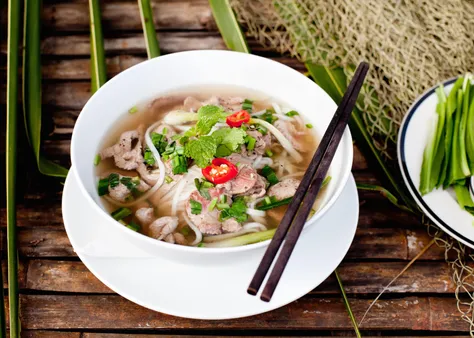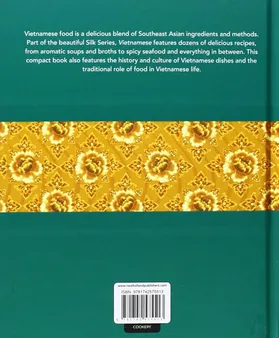Table of Contents
Welcome to Tauhuichiban, your trusted guide to the culinary delights of Vietnam! Vietnamese cuisine is a vibrant and diverse tapestry of flavors, textures, and traditions, with a rich history that spans centuries. Join us on a journey through The history and culture of Vietnamese food, as we explore the key ingredients, cooking techniques, regional variations, and the cultural significance of traditional Vietnamese dishes. From the humble origins of rice farming to the fusion of international flavors, Vietnamese food tells a story of innovation, resilience, and the deep connection between food and culture. So sit back, relax, and let us take you on a culinary adventure through the vibrant world of Vietnamese cuisine.

The history and culture of Vietnamese food: A journey through flavors and traditions
I. The History of Vietnamese Cuisine
Influences from China, India, and Southeast Asia have shaped the unique flavors of Vietnamese cuisine. Originally cultivated for rice farming, the Vietnamese diet revolves around rice, noodles, and herbs. Fish sauce, soy sauce, and other sauces add umami to dishes, while traditional cooking methods like stir-frying and steaming preserve the freshness of ingredients.
Regional variations have developed over time. Northern cuisine is known for its delicate flavors and use of fermented foods, while Central cuisine is influenced by royal court cuisine and features bold flavors. Southern cuisine is characterized by its use of coconut milk and fresh herbs. Traditional Vietnamese dishes like pho, banh xeo, and goi cuon are beloved around the world.
Northern Cuisine | Central Cuisine | Southern Cuisine |
|---|---|---|
Pho Banh cuon | Hue royal cuisine Banh khoai | Bun mam Banh xeo |
II. The Cultural Significance of Vietnamese Food
Beyond sustenance, Vietnamese food holds cultural and historical significance. It is an integral part of festivals and celebrations, symbolizing family, community, and tradition. The etiquette of Vietnamese dining involves sharing dishes, using chopsticks correctly, and respecting the host. Restaurants such as Pho Quynh and Quan An Ngon offer authentic dining experiences.
Vietnamese food has also gained international recognition. Chefs such as Andrea Nguyen and Charles Phan have introduced Vietnamese cuisine to a global audience. The popularity of Vietnamese food has led to the establishment of Vietnamese restaurants in cities around the world, showcasing its diverse flavors and rich culinary heritage.
- Festivals:Tet (Lunar New Year), Mid-Autumn Festival, Hung Kings Festival
- Celebrations:Weddings, funerals, birthdays
- Traditions:Ancestor worship, family meals

The History of Vietnamese Cuisine
III. The Cultural Significance of Vietnamese Food
Eating is closely tied to Vietnamese culture, with food playing a significant role in all aspects of life, from regular family meals to religious ceremonies. Vietnamese cuisine has a diverse history, influenced by the country's geography, migration patterns, and cultural exchanges with neighbors and former colonizers, resulting in a rich and nuanced culinary tradition.
Vietnamese people place great importance on eating together, and large meals accompanied by a variety of dishes to serve diners of all ages are not only the norm but a symbol of conviviality. Food is central to hospitality, and the best way to show respect for your hosts is to eat everything on your plate, even if it means trying dishes that might seem strange, especially to Western visitors.
IV. Rice | V. Nuoc Cham | VI. Pho |
|---|---|---|
Rice is the staple food in Vietnam and is eaten at almost every meal, in abundance. | Vietnam's beloved dipping sauce, Nuoc Cham is typically made from fish sauce, lime juice, and sugar. | This noodle soup is widely recognized as perhaps the most common and popular Vietnamese dish globally. |
Food also holds a deep cultural significance, and many Vietnamese festivals and holidays revolve around special foods that honor ancestors, bring in good fortune, or mark significant life events like weddings.
Vietnamese dining etiquette is also fascinating, with various customs, table manners, and dining rituals that have evolved over the years. For example, the eldest person at the table is traditionally served first as a sign of respect, and guests should avoid making noise while chewing to show appreciation for the meal.

The Cultural Significance of Vietnamese Food
VII. Regional Variations in Vietnamese Cuisine
The culinary landscape of Vietnam is a diverse tapestry of flavors and traditions, with each region boasting its own unique specialties and cooking techniques. From the delicate flavors of the north to the bold and spicy dishes of the south, Vietnamese cuisine offers a tantalizing journey for the taste buds.
In the north, the cuisine is characterized by its subtle and refined flavors. Dishes often feature light sauces, fresh herbs, and grilled meats. Some of the most popular dishes from the north include pho, a beef noodle soup; bun cha, a grilled pork noodle dish; and cha ca, a grilled fish dish. Discover the best places to savor Vietnamese cuisine in Ho Chi Minh City
Region | Characteristics | Popular Dishes |
|---|---|---|
North | Subtle and refined flavors, light sauces, fresh herbs, grilled meats | Pho, bun cha, cha ca |
Central | Spicy and flavorful dishes, use of seafood, coconut milk | Bún bò Huế, Cao lầu, Mì Quảng |
South | Bold and spicy flavors, use of rice, noodles, and tropical fruits | Cơm tấm, Bánh xèo, Hủ tiếu |
Moving south, the cuisine becomes more spicy and flavorful. Dishes often incorporate seafood, coconut milk, and tropical fruits. Some of the most popular dishes from the south include bun bo Hue, a spicy beef noodle soup; cao lau, a pork and noodle dish; and mi quang, a turmeric-infused noodle dish. Explore the health benefits of Vietnamese cuisine
In addition to these regional variations, Vietnamese cuisine has also been influenced by neighboring countries such as China, Laos, and Cambodia. This has resulted in a rich and diverse culinary heritage that continues to evolve and delight diners around the world.

Regional Variations in Vietnamese Cuisine
VIII. The Future of Vietnamese Food
Technology and Innovation
- Online food delivery and meal kits
- Smart kitchen appliances and cooking gadgets
- Artificial intelligence and personalized dining experiences
Sustainability and Health
- Focus on locally sourced and organic ingredients
- Plant-based and vegetarian options
- Emphasis on healthy cooking techniques and mindful eating
Fusion and International Influences
- Continued blending of Vietnamese flavors with international cuisines
- Experimentation with new ingredients and cooking methods
- Rise of Vietnamese fusion restaurants and chefs
Preservation and Tradition
- Efforts to preserve traditional Vietnamese recipes and cooking techniques
- Support for local farmers and food artisans
- Education and awareness about Vietnamese food culture
The Future of Vietnamese Food
The future of Vietnamese food is bright andå 满å¸æ. With its rich history, diverse flavors, and innovative spirit, Vietnamese cuisine is poised to continue to captivate and inspire diners around the world. As technology, sustainability, and global influences shape the culinary landscape, Vietnamese food will undoubtedly evolve and adapt, while remaining true to its core traditions and flavors.

The Future of Vietnamese Food
IX. Conclusion
The history and culture of Vietnamese food is a testament to the resilience, creativity, and cultural diversity of the Vietnamese people. From its humble origins to its vibrant present-day scene, Vietnamese cuisine has evolved and adapted to reflect the changing tastes and influences of its time. Today, Vietnamese food is enjoyed all over the world, celebrated for its fresh ingredients, bold flavors, and the unique stories it tells. As the culinary traditions of Vietnam continue to evolve, one thing remains certain: the history and culture of Vietnamese food will continue to inspire and delight generations to come.